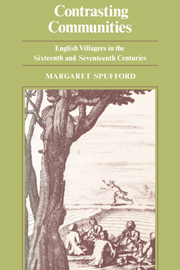Book contents
- Frontmatter
- Contents
- List of maps and graphs
- List of tables
- List of abbreviations
- Acknowledgements
- Dedication
- Introduction
- Map 1 Cambridgeshire: natural boundaries and soil types
- Map 2 Cambridgeshire: county and parish boundaries
- PART 1 People, Families and Land
- PART 2 The Schooling of the Peasantry
- 6 A general view of schools and schoolmasters
- 7 The elementary ability to write: Willingham and Orwell
- 8 The importance of reading in the village community
- PART 3 Parishioners and their Religion
- Conclusion
- Appendix 1 The Butlers of Orwell
- Appendix 2 Notes on Graphs 3 and 5
- Index of Contemporary Names
- General Index
7 - The elementary ability to write: Willingham and Orwell
Published online by Cambridge University Press: 25 January 2010
- Frontmatter
- Contents
- List of maps and graphs
- List of tables
- List of abbreviations
- Acknowledgements
- Dedication
- Introduction
- Map 1 Cambridgeshire: natural boundaries and soil types
- Map 2 Cambridgeshire: county and parish boundaries
- PART 1 People, Families and Land
- PART 2 The Schooling of the Peasantry
- 6 A general view of schools and schoolmasters
- 7 The elementary ability to write: Willingham and Orwell
- 8 The importance of reading in the village community
- PART 3 Parishioners and their Religion
- Conclusion
- Appendix 1 The Butlers of Orwell
- Appendix 2 Notes on Graphs 3 and 5
- Index of Contemporary Names
- General Index
Summary
The communities I am concerned with were strongly contrasted socially. Willingham was a fen village, in which the economy was based largely on stock-raising rather than on the arable holdings. This economy produced a very different social structure from that of the uplands. In 1575, only one man held an arable acreage appropriate to a yeoman in the south of the county; the backbone of the community was formed by the holders of the twenty-eight half-yardlands. These men were only copyhold tenants of between thirteen and twenty-three acres of arable, but here, on the edge of the fen, they were men of substance, and in their wills they described themselves as yeomen. These wills give the impression of prosperity in the last quarter of the sixteenth century, at a time when the upland counterparts of such men were losing their holdings because they were unable to withstand the combined economic pressures of the price rise and frequent bad harvests. During the seventeenth century there was an influx of people into Willingham, and probably a rise in the resident population too, because the opportunities provided by the fen meant that it was possible to exist on a relatively small holding.
- Type
- Chapter
- Information
- Contrasting CommunitiesEnglish Villages in the Sixteenth and Seventeenth Centuries, pp. 192 - 205Publisher: Cambridge University PressPrint publication year: 1974
- 1
- Cited by



